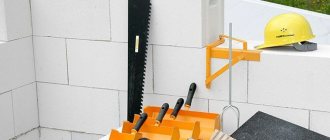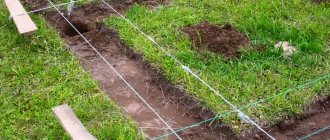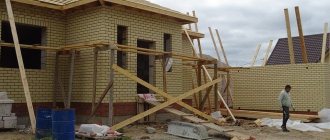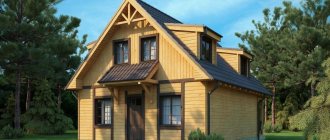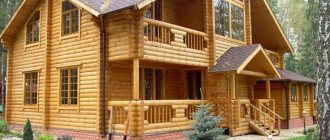Friends, hello everyone! I decided to touch on the topic of building a house because there is too much information on the Internet, of varying degrees of usefulness, on this subject. And it’s quite difficult to immediately select the right one for a non-professional. You have to sit for a long time, rummage through materials and filter out nonsense or manipulation. If you type “how to choose a plot” into a search engine, then the first couple of pages you will receive paid materials from real estate agencies whose purpose is not to provide reliable information. The purpose of such material is to lead the reader to the idea of buying a plot of land from the site owner or advertising company. In addition, it is useful to know the information so as not to fall for the tricks of dishonest construction organizations or realtors.
Important note! I am not a builder or an engineer by training. I just came across this issue from personal experience and want to help other people save money, time and nerves. Along the way, I will provide links to materials I liked on this topic. If you have any questions or additions while reading, or find errors, please leave your comments under the post so that other readers receive the most useful and reliable information.
What to consider when choosing
To build a new individual housing, it is necessary to decide on its dimensions, shape, type of materials, arrangement of rooms, climate control system and some other parameters. However, all these worries will be in vain if the developer does not initially know how to choose a plot of land for building a house. First of all, the following series of criteria must be taken into account:
- Personal preferences of future owners.
- Territorial location relative to natural or artificial formations - south or north of a city, river, forest, mountains, plains, etc.
- Distance to large settlements and industrial centers.
- Availability of electrical networks , water and gas pipelines , cell towers and other communication systems.
- Transport interchanges , communication centers, types of vehicles, convenience and time spent on the way to work, school and other necessary places.
- Physical and geological characteristics of the area (site slope, groundwater level, presence of reservoirs, soil type).
- Legal status of future possessions.
Plot on level ground Source greenbelarus.info
Important! All of the factors discussed above affect the final price of the plot. For many, cost is the determining factor. In this case, the choice according to other criteria is made based on budget restrictions.
Ecology
The desire to live in clean air is one of the main reasons why people move out of town. If it is important for you to build a house in an environmentally friendly place, then before purchasing land, find out if there are any industrial enterprises, waste incinerators, or landfills nearby. It is also not advisable for a high-voltage power line to pass near the site. Let us note that there are significantly more environmentally friendly areas in the Leningrad region than polluted ones, and living outside the city is much healthier than in a noisy and polluted metropolis.
Distance to city
The first factor when choosing a site is the distance to the city. Even if everyone who will live in the house works and studies remotely or is retired and does not directly depend on large settlements, nevertheless, the condition of proximity to a metropolis or large village is mandatory. This is due to the following number of necessary circumstances:
- Replenishment of food and material base.
- Use of medical services, including emergency ones.
- Interaction with emergency services during the development of an emergency.
- Visiting other objects of interest (clubs, theaters, shops, exhibitions, etc.).
In addition, modern man is accustomed to living in society - he needs communication. It is unlikely that anyone will be able to leave the team, friends, or relatives for a long time. Therefore, from this point of view, you also need to know how to choose a site for building a house, so that, due to making a hasty emotional decision, you do not end up in social isolation for a long time.
House with a plot in the suburbs Source moresezon.ru
A dwelling in the wilderness is good only for periodic residence. It will be useful for weekend trips, picnics, fishing, and hunting. For permanent residence, it is better to choose a place as close as possible to a large city, in the suburbs or in its more or less ecological region.
The site should not be too remote, but also not located near a busy part of the city. Its location is optimal when the following conditions are met:
- It takes no longer than 1-1.5 hours to get to work/study/business meeting.
- It takes no more than half an hour to get to the nearest kindergarten or school by your own car, taxi, train or bus.
- Densely populated areas, busy highways or industrial enterprises are located on the other side of the city.
Interesting fact! Since in most cases the limiting factor in choosing land for a house is cost, it turns out to be more profitable to buy outside the city. The price for a plot outside the city limits on average drops 10 times compared to a place of similar size in a metropolis.
Plot in a village with developed infrastructure Source bolgariadom.com
See also: Catalog of popular plots in the Moscow region for the construction of a country house
Tip 3 - choose an environmentally friendly area
In my opinion, ecology is the second most important factor (after price). The cleanliness of the air and the absence of harmful impurities in it are affected by the activities of industrial enterprises, proximity and congestion of roads. As a rule, industrial zones are concentrated in certain areas of the city, but there are also single-industry towns where it is impossible to hide from the factory smog. As for highways, there is no definite answer here, since roads are constantly expanding and new ones are being added. To be on the safe side, it is better to refer to the urban planning plan of the territory where you have your eye on the site.
The presence or absence of forests near a suburban area also influences the choice. It’s always good to plunge into the coolness of a coniferous forest or walk through a birch forest to pick mushrooms, or pick raspberries and strawberries in sunny meadows. But just 2-3 such trees on your site can become a real problem - cutting down requires a documentary permit (cutting ticket) and a gigantic effort to uproot.
Trees on the site are great until it comes to construction...
Is it worth buying a plot of land in a water protection zone?
Geometry, dimensions and relief
When choosing land for a house, such parameters as the terrain, the size of the plot and the geometric shape are of no small importance.
Relief
Traditionally, geodesy considers three types of relief of a building site:
- Plain.
- Hills.
- Lowland.
The plain is an ideal option for creating a manor. In addition to the house, in this type of area you can organize gardens, vegetable gardens and other types of homestead farming as large as you like. It’s easy to build on it, and it’s convenient to transport materials. Disadvantages - possible increased wind load, as well as excessive exposure to sunlight. In addition, water often stagnates out of the blue. Therefore, the arrangement of drainage is almost always necessary.
On hills, housing can be built in completely different conditions - on level ground and on a slope. In any case, a reinforced foundation is required. Under the influence of natural factors (earthquake, wind, rain), the foundation may be destroyed. The advantages of building on a hill are opening views of the expanses of the surrounding area, quick drainage of water in case of heavy rains, a ventilated atmosphere and always fresh air.
Plot with a house on a hill Source dilani.ru
In low-lying areas, the home and surrounding area are less exposed to winds. Increased accumulation of water will favor the development of garden crops. However, the minimum relief points have their own number of disadvantages - their own microclimate (even in summer there are frosts), flooding during the rainy season and during downpours (drainage is required), smog, fog, and air stagnation.
Advice! To know how to choose the right site for building a house, taking into account the type of soil, you need to decide whether garden crops will be grown in the local area. If the latter are excluded, special importance should not be attached to the type of soil. On the other hand, plants develop well on black soil and in floodplain areas.
House with a garden plot Source sm-news.ru
Site characteristics
You need to carefully study the cadastral data about the site, find out what its relief is, its size, and whether there are any disputes with neighbors about trespassing.
The above factors are just the tip of the iceberg. Depending on the owner’s plans for the site, it will also be necessary to take into account the suitability of the land for gardening, whether it is possible to dig a well and other characteristics.
Plot size
According to experts, the footage of the plot should be in proportion to 10:1 in relation to the house. That is, if the owner is going to build a one-story house with an area of 150 square meters. m., it is advisable to buy an area of 15 acres. This will allow you to comply with construction rules (there must be a certain distance between all buildings on the site, between buildings and the fence), as well as place a garden, vegetable garden, and recreation area on the site.
However, if the budget is limited, then you can get by with the standard six hundred square meters, and simply divide the footage of the house into several floors.
Land quality
The soil should not be too clayey or wet. This can lead, over time, to subsidence or even collapse of the house. There are two ways to check the quality of the soil: by inviting surveyors or asking neighbors. It is best to require a professional geodetic survey from the seller at his expense.
The site should also be checked for the depth of groundwater. If they are close, you can forget about building a large house, at most - a “frame” on stilts.
It is also recommended to check such factors as the presence of dangerous bodies of water nearby. In spring, rivers and some lakes flood. You can ask your neighbors if there is any flooding in the areas in the spring.
Landscape
A beautiful landscape with an abundance of hills, slopes and lawns is the dream of many gardeners, however, when it comes to residential construction, a multi-level plot brings more problems than pleasure.
Even a slight slope in one direction, the presence of one hole or subsidence zone, makes the site unsuitable for building a house. To fix this, you have to level the landscape, fill some soil, and remove it somewhere. It costs a lot.
It is better to purchase areas with flat terrain in order to build a foundation without any problems. And small hillocks and other landscape objects can be created independently after building the house. To do this, you only need bags of ordinary soil and a construction cart, while the arsenal of tools for leveling a site for a house is much more complex and expensive, including expensive rental of special equipment.
Form
Irregularly shaped areas are very difficult to fence and, most importantly, to measure correctly and enter into the cadastral register. During measurements, disputes may arise with neighbors, which may even end in court.
To avoid unnecessary problems, it is better to purchase possessions of the correct shape - rectangular or square.
Geological features of the soil
The design features of the foundation, the structure itself and its surrounding area largely depend on the type of soil. There are 4 main types:
- Rocky.
- Dispersed.
- Frozen.
- Technogenic.
Moreover, the second type is most common in natural conditions, which in turn is divided into 4 subspecies:
- Clay.
- Sand.
- Il.
- Peat.
Modifications from the first two are ideal for development - loam, sandy loam and rock. On swampy, muddy and peaty soil, the building will be unstable and will quickly collapse. Also, in order to know how to choose the right plot of land for building a house, based on the geological features of the soil, you need to have an understanding of groundwater. They can be deep and superficial.
In the first case, groundwater does not pose a danger. In the second case, a house can only be built on a special foundation and with the obligatory creation of a drainage system. Otherwise, during seasonal floods or soil heaving, the structure will quickly become unusable. At the same time, the construction of a buried foundation and the arrangement of drainage will make a significant contribution to the final cost of the structure.
Drainage on a site with a house Source stroyfora.ru
Transport interchanges and communications
The comfort of living in a house largely depends on the availability of modern communications:
- Electricity of the net.
- Gas pipeline.
- Water pipes.
- Sewer system.
- Heat supply.
- Means of communication.
- Security.
Naturally, the more benefits of civilization are available, the higher the cost of land. However, their presence is required only for permanent residence. For a summer residence, a constant power supply is sufficient, and in some cases it can be replaced by an autonomous diesel station, battery or alternative energy generators.
Almost all life support systems are divided into autonomous and centralized. Gas for the stove and heating boiler can come from an individual underground tank or from the main line. Water can be pumped from a well on the site or come from a water supply. The sewerage system can also be made in the form of a septic tank or connected to a common system.
Bringing communications to the house Source beautiful-uchastok.rf
The choice in favor of one option or another depends on the final cost of installing the systems and their availability. For example, a dwelling built far from the city and any engineering systems will be completely autonomous. At the same time, on a site in the suburbs it may be more profitable to connect to the city water supply than to drill your own well.
To know how to choose a site for building a private house, you need to take into account the availability of access roads. It is unlikely that anyone would like to drive every day on gravel or dirt roads, especially in the spring or during the rainy season. However, having a paved road will also contribute to the overall value of the land.
Important! Convenient, close transport links are an advantage when frequent travel is necessary. For lovers of a secluded life against the backdrop of nature, they will be an additional obstacle and a factor of discomfort.
Land category
Most often, plots intended for individual housing construction (IHC) and dacha lands located in horticultural non-profit partnerships (SNT) and dacha non-profit partnerships (DNP) are put up for sale. You can find out which category a particular plot belongs to from the certificate of ownership kept by the seller. What are the main differences between these types? Land for individual housing construction allows the owner to build a residential building and other household buildings, as well as plant a garden or vegetable garden. Before starting construction, the future owner must obtain permission. You can register your relatives in the built house. On country and garden lands, you can also build a permanent cottage, register it and receive a certificate of ownership, but it is possible that registering in it will be problematic. One of the advantages of such plots is the absence of the need to obtain a building permit.
Legal aspects
Purchasing a plot requires mandatory verification from the seller of the following documents:
- Registration of property rights.
- Certificates of ownership.
- Cadastral passport.
- A certificate containing the standard price of land.
- Confirmation of absence of buildings.
- Evidence that there are no debts.
- Consent of the spouse (if selling by an individual).
- Permissions from the guardianship authorities (if there is a minor owner).
To understand how to choose land for building a house, when it comes to various forms of territorial entities, it is necessary to consider their features. For example, buying a plot of land in SNT will cost 5 times less than in a cottage village. However, if in the future the home will be used as a permanent place of residence, its arrangement will cost a similar amount or even more. Plus, the worries and efforts of laying communications will be added to this.
House in a cottage village Source countryside-cdn.cian.site
For example, despite the high cost of land, individual housing construction has the following number of advantages compared to SNT:
- Full disposal of your own land - regardless of the decisions of the team and the chairman.
- Maximum precision boundary delineation.
- A full set of communications - gas, electricity, water, security, sewerage, heat, internet, etc.
- Registration.
- Available social services - medicine, kindergartens, schools, Ministry of Emergency Situations.
Note! The outermost area in the village is not only close to nature, lack of noise and gas pollution from the highway, but also an increased crime situation. A house on the outskirts is always the object of increased attention from intruders. Therefore, housing in a remote place requires full-fledged security measures.
Tip 4 - Study the infrastructure
Infrastructure and utilities are in third place in my mini-rating, and the most important thing here is electricity.
Electricity supply
Formally, connecting electricity to a plot of land costs about 600 rubles, but in practice this amount can increase 100 times or more. This is due to the lack of ability or desire of local authorities to extend power grids at budget expense. In this case, the installation of an electrical substation (transformer), the purchase and installation of power line supports, the purchase and tension of wires fall on the shoulders of the owners.
Gas supply
The second most important utility network is gas. The cost of gas in cylinders is significantly higher (now a 50-liter cylinder costs about 800 rubles) than the cost of natural gas. In just one, not the coldest winter, heating a house of 150 sq. m of bottled gas will cost 80,000 rubles, whereas for mains gas you will pay only 10,000. Connecting a house to a gas pipeline rarely costs more than 150,000 rubles.
Water supply
Most private developers, when choosing a land plot, for some reason forget about water supply. There are cases when only after construction people realize that the water in the well they drilled is extremely ferruginous. Iron content can be 30 times higher than normal. Such water is not suitable for technical needs or for drinking, and filtration will cost a pretty penny. The most effective way to avoid such a situation is to obtain information about water quality from future neighbors.
Sewerage
It may be central, but installing a septic tank on the site costs no more than 35,000 rubles. To save money, you can install one septic tank for two houses together with neighbors.
How to choose a septic tank for your home
Driveways
The ideal option is when the street runs along an asphalt road maintained by the municipality. But unpaved access roads are also a working option. The quality of such a road is best assessed in the spring, when the snow melts.
The ability to connect electricity, water, gas, sewerage, the presence of roads, schools and shops create conditions for a comfortable existence and make positive adjustments when valuing the land. You need to understand that life becomes very complicated when at least one of the listed communications is missing in the house.
Briefly about the main thing
You can get useful information about how to choose a site for a house if you carefully analyze the following number of factors:
- Own preferences.
- Proximity to the city or large populated areas.
- The terrain, dimensions and shape of the allotment.
- Soil composition, groundwater level.
- Availability of engineering networks and communications.
- Condition of transport junctions and roads.
- Correctness of documents.
It is also important in which municipality the land is located - SNT, cottage village, suburb, urban environment. The cost and availability of all the benefits of civilization depend on this.
Ratings 0


